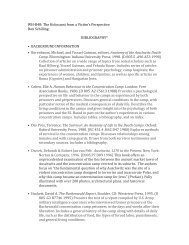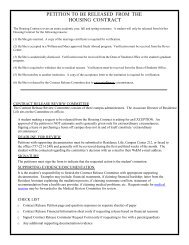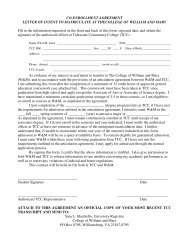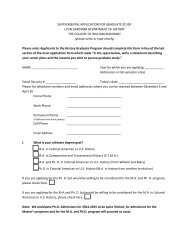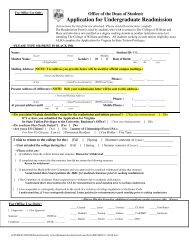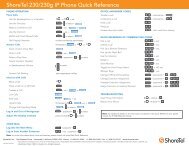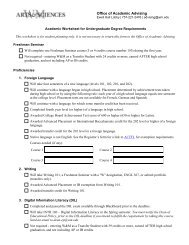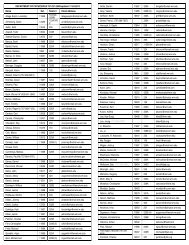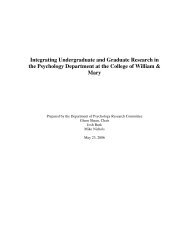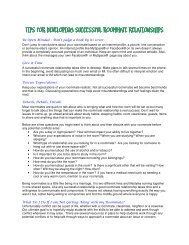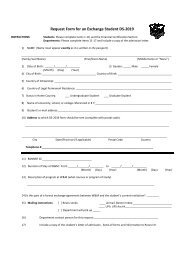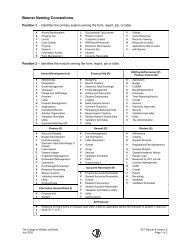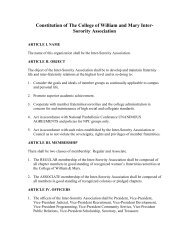Course Selection Guidebook [pdf] - College of William and Mary
Course Selection Guidebook [pdf] - College of William and Mary
Course Selection Guidebook [pdf] - College of William and Mary
You also want an ePaper? Increase the reach of your titles
YUMPU automatically turns print PDFs into web optimized ePapers that Google loves.
<strong>Course</strong> <strong>Selection</strong> <strong>Guidebook</strong> – Fall 2011I. IntroductionThis guidebook has been prepared to give entering freshmen a focused introduction to first semestercourse selection. Each department in Arts <strong>and</strong> Sciences, where all freshman courses are taken, hasprovided information about its program <strong>and</strong> suggested introductory courses most appropriate toentering freshmen. When used in conjunction with the online schedule <strong>of</strong> classes, this guidebookwill allow entering freshmen to select an appropriate set <strong>of</strong> courses for the Fall 2011 semester.Information is also provided about degree programs in the Mason School <strong>of</strong> Business <strong>and</strong> the School<strong>of</strong> Education. Students do not, however, enter these programs until the junior year. Please note thatgrade-point-average restrictions <strong>and</strong> prerequisite course requirements must be met before entry intothese schools. Acceptance to <strong>William</strong> & <strong>Mary</strong> does not automatically guarantee acceptance intothese programs.II.Hints on <strong>Course</strong> <strong>Selection</strong>Your first two years <strong>of</strong> courses will be used to fulfill General Education Requirements (GERs); tomeet the <strong>College</strong>’s language <strong>and</strong> writing pr<strong>of</strong>iciency requirements; to complete the freshmanseminar requirement; <strong>and</strong> to explore disciplines with the goal <strong>of</strong> declaring a major at the end <strong>of</strong> yoursecond year. While some students enter college with a particular major, career, or pr<strong>of</strong>ession inmind, many will change their minds several times in the course <strong>of</strong> their studies. The best approach tocourse selection is one <strong>of</strong> flexibility <strong>and</strong> openness to change. When choosing courses for your firstsemester, there are a number <strong>of</strong> useful hints to keep in mind. First, read the following section on“General Education Objectives” to set the framework for pursuing undergraduate study in a liberalarts environment <strong>and</strong> then consider the following guidelines:1) Complete the Freshman Seminar requirement during the first OR second semester.2) Complete the pr<strong>of</strong>iciencies <strong>and</strong> GERs as soon as possible.3) Take a course or courses in subjects that are potential majors.4) Build on strengths by choosing some subjects familiar to you <strong>and</strong> some that grow out <strong>of</strong> yourreflections on our general education objectives.5) Try some subjects that are new to you.6) Balance your program so that courses do not cluster around a single area.7) Be aware that certain majors have course requirements that are outside <strong>of</strong> the major (seeSection III).8) Use your Advanced Placement <strong>and</strong> International Baccalaureate or dual enrollment transfercredits to fulfill GER, pr<strong>of</strong>iciency, <strong>and</strong> major requirements (see Section IV <strong>and</strong> V).A typical first-semester load will consist <strong>of</strong> 4 or 5 academic courses. Most courses are one semesterin length <strong>and</strong> are worth three or four credits. A typical three-credit course will meet for 50 minuteson Monday, Wednesday, <strong>and</strong> Friday or for 75 minutes on Tuesday <strong>and</strong> Thursday. <strong>Course</strong>s worthfour credits will have additional meeting times (e.g. science labs, language drills, etc.). Do notundertake too much in your first semester. A semester <strong>of</strong> adjustment to the greater dem<strong>and</strong>s <strong>of</strong>college work is quite appropriate. A full-time load is 12-18 credits, with a typical first semesterfreshman load averaging 13-14 credits.2


![Course Selection Guidebook [pdf] - College of William and Mary](https://img.yumpu.com/46952524/2/500x640/course-selection-guidebook-pdf-college-of-william-and-mary.jpg)
